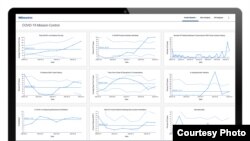As the COVID-19 pandemic threatens to overwhelm doctors and hospitals throughout the country, medical technology firms and health centers are trying to gain “situational awareness” — giving doctors what they need to know about the sick patients filling emergency rooms.
For doctors and staff, “it’s really hard to know what sorts of patients are coming,” said Warren Ratliff, the chief executive of MDmetrix, a software firm that provides analysis of health care inside hospitals.
The staff “can see they're backing up,” he said. But they have few tools to compare patients showing up today with those admitted yesterday, or to show what treatments might be working on certain groups of patients, he added.
A frustrated doctor
MDmetrix was created by a doctor frustrated that he couldn't analyze data across patients. With electronic medical records, which have been in use in the U.S. for years, mostly for tracking and billing, physicians typically view one patient's record at a time.
Enter medical technology firms like MDmetrix, which offer information dashboards and apps so that doctors and hospitals can look for trends and insights across patient outcomes. The technology pulls data from patients’ electronic medical records.
As they deal with the patients in front of them, hospitals and doctors are struggling to answer what may seem like simple questions, Ratliff said. How many ventilators are being used? Is low oxygen an indicator of COVID-19? Has anyone followed up on patients who were tested and sent home?
The demand for information extends to whether there are different treatments for different groups, he said.
Different patients, different treatments
“Is there a difference in the treatment between smokers or nonsmokers?” Ratliff said. “In a couple of years, an after-action report will come out. But that's way too late if you're fighting a battle right now.”
With the push of a button, clinicians and hospital administrators get MDmetrix’s COVID-19 dashboard of charts and graphs that they can view to improve patient care. The information is a real-time snapshot of “whether treatment protocol A is working better than protocol B for any subset of patients,” Ratliff said.
As for privacy concerns, data pulled from patient records is stripped of its identity and aggregated, complying with health care privacy laws, Ratliff said.
MDmetrix is being used at the University of Washington Medical Center and Harborview Medical Center, both in Seattle. The company is providing its “COVID-19 Mission Control” software for free to hospitals and medical centers.
Leveraging the electronic health record
A recent paper in the Journal of American Medical Informatics Association outlined efforts at the University of California San Diego Health to quickly build new dashboards based on electronic health records to manage the growing crisis. The authors conclusion: Electronic health records “should be leveraged to their full potential.”
Over the past several years, there’s been an explosion of technology tools to analyze and aggregate data drawn from electronic health records, said Julia Adler-Milstein, an associate professor of medicine at the University of California-San Francisco. But the COVID-19 pandemic is pushing hospitals and companies to find ways – sometimes in just days – to analyze data and get critical information to decision-makers.
“This has been a pressure test,” she said. “How can we get cuts of our data for the new disease?”
Figuring out trends inside a hospital is also the work of TransformativeMed, an electronic record-keeping application that tracks a patient as he or she moves through the hospital. It is being used at the University of Washington Medical Center and Harborview Medical Center; MedStar Health in the Washington, D.C., area; and VCU Health Center in Richmond, Virginia.
Tracking a patient — from symptoms, lab results and treatments — can help a hospital understand how a disease is progressing through a community, how effective treatments are and what isn’t working, said Dr. Rodrigo Martinez, chief clinical officer at TransformativeMed and an ear, nose and throat doctor.
A generational opportunity
The battle against COVID-19 could be a once-in-a-generation opportunity to greatly improve the health care system, he said. The social distancing requirements will boost telehealth, with patients and their health care providers likely to appreciate how much can be accomplished through video chat, he said. 3-D printing, which is being used to repair and create ventilators, will help the medical supply chain. And home lab tests will also likely grow.
Add to the list companies such as TransformativeMed and MDmetrix, which are finding trends in patients’ electronic health records.
“It’s not that we are creating new technologies,” Martinez said. “We’ve had technologies waiting in the wings, waiting for the opportunity to be applied.”








